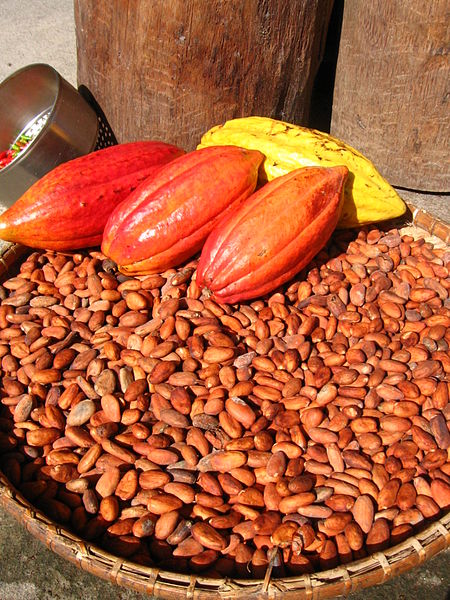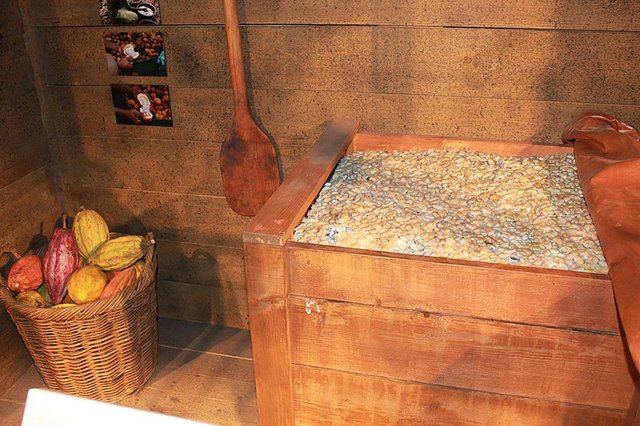Chocolate: The Sweet Side of Fermentation
Chocolate could be characterized as the "world's favorite food," but few people realize that fermentation is an essential part of chocolate production. The Aztecs were the first to develop chocolate fermentation, serving a chocolate drink made from the seeds of the chocolate tree, Iheobroma cacao (Greek theos, god, and broma, food, or "food of the gods").
Chocolate trees now grow in Africa as well as South America.

Image Source: Wikimedia CC BY 2.0 Author: Lolay
The process of chocolate fermentation has changed very little over the past 500 years. Each tree produces large pods that each hold 30 to 40 seeds in a sticky pulp (box figure). Ripe pods are harvested and slashed open to release the pulp and seeds. The sooner the fermentation begins, the better the product, so fermentation occurs on the farm where the trees are grown. The seeds and pulp are placed in "sweat boxes" or in heaps in the ground and covered, usually with banana leaves. Like most fermentations, this process involves a succession of microbes. First, a community of yeasts, including Candida rugosa and Kluyveromyces marxianus, hydrolyzes the pectin that covers the seeds and ferments sugars to release ethyl alcohol and carbondioxide. As the temperature and the alcohol concentration increase, the yeasts are inhibited and lactic acid bacteria increase in number. Lactic acid production drives the pH down, encouraging the growth of bacteria that produce acetic acid as a fermentation end product. Acetic acid is critical to the production of fine chocolate because it kills the sprout inside the seed and releases enzymes that cause further degradation of proteins and carbohydrates, contributing to the overall taste of the chocolate. In addition, acetate esters, derived from acetic acid, are important for the development of good flavor. Fermentation takes 5 to 7 days. An experienced cocoa grower knows when the fermentation is complete: if it is
stopped too soon, the chocolate will be bitter and astringent; if it lasts too long, microbes start growing on the seeds instead of in the pulp. "Off tastes" arise when Gram-positive bacteria in the genus Bacillus and filamentous fungi belonging to the genera Aspergillus, Penicillium, and Mucor hydrolyze lipids in the seeds to release short-chain fatty acids. As the pH begins to rise, bacteria of the genera Pseudomonas, Enterobacter, and Escherichia also contribute to bad tastes and odor.

Images Source: Wikimedia CC BY-SA 4.0 Author: Pakeha
After fermentation, the seeds, now called beans, are spread out to dry. The dried beans are brown and lack pulp. They are bagged and sold to chocolate manufacturers, who first roast the beans to further reduce the bitter taste and kill most of the microbes. The beans are then ground and the nibs-the inner part of each bean-are removed. The nibs are crushed into a thick paste called a chocolate liquor, which contains cocoa solids and cocoa butter but no alcohol. Cocoa solids are brown and have a rich flavor, and cocoa butter has a high fat content and is off-white in color. The two components are separated, and the cocoa solids can be sold as cocoa, while the cocoa butter is used to make white chocolate or sold to cosmetics companies for use in lipsticks and lotions. However, the bulk of these two components will be used to make chocolate. The cocoa solids and butter are reunited in controlled ratios, and sugar, vanilla, and other flavors are added. The better the fermentation, the less sugar needs to be added (and the more expensive the chocolate).
.jpg)
Image Source: Wikimedia
CC BY-SA 2.5 Author: André Karwath aka Aka
The final product, delicious chocolate, is a combination of over 300 different chemical compounds. This mixture is so complex that no one has yet been able to make synthetic chocolate that can compete with the natural fermented plant. Microbiologists and food scientists are studying the fermentation process to determine the role of each microbe. But like chemists, they have had little luck in replicating the complex, imprecise fermentation that occurs on cocoa farms. In fact, the finest, most expensive chocolate starts as cocoa on farms where the details of fermentation have been handed down through generations. Chocolate production is truly an art as well as a science, while eating it is simply divine

Image Source: Wikimedia CC BY-SA 4.0 Author: Kathilein962
You can also read about my previous science article here Wolbachia pipientis: The World's Most Infectious Microbe?.
References
How does the fermentation process work on the cocoa bean and how long does it take?
Cocoa Fermentation — Bringing Magic to the Cocoa
The microbiology of cocoa fermentation and its role in chocolate quality.
Thanks for reading, still me, Donaldpete 😁😁
Hey, I'm somehow unable to find you on discord. Please contact me Suesa#4095